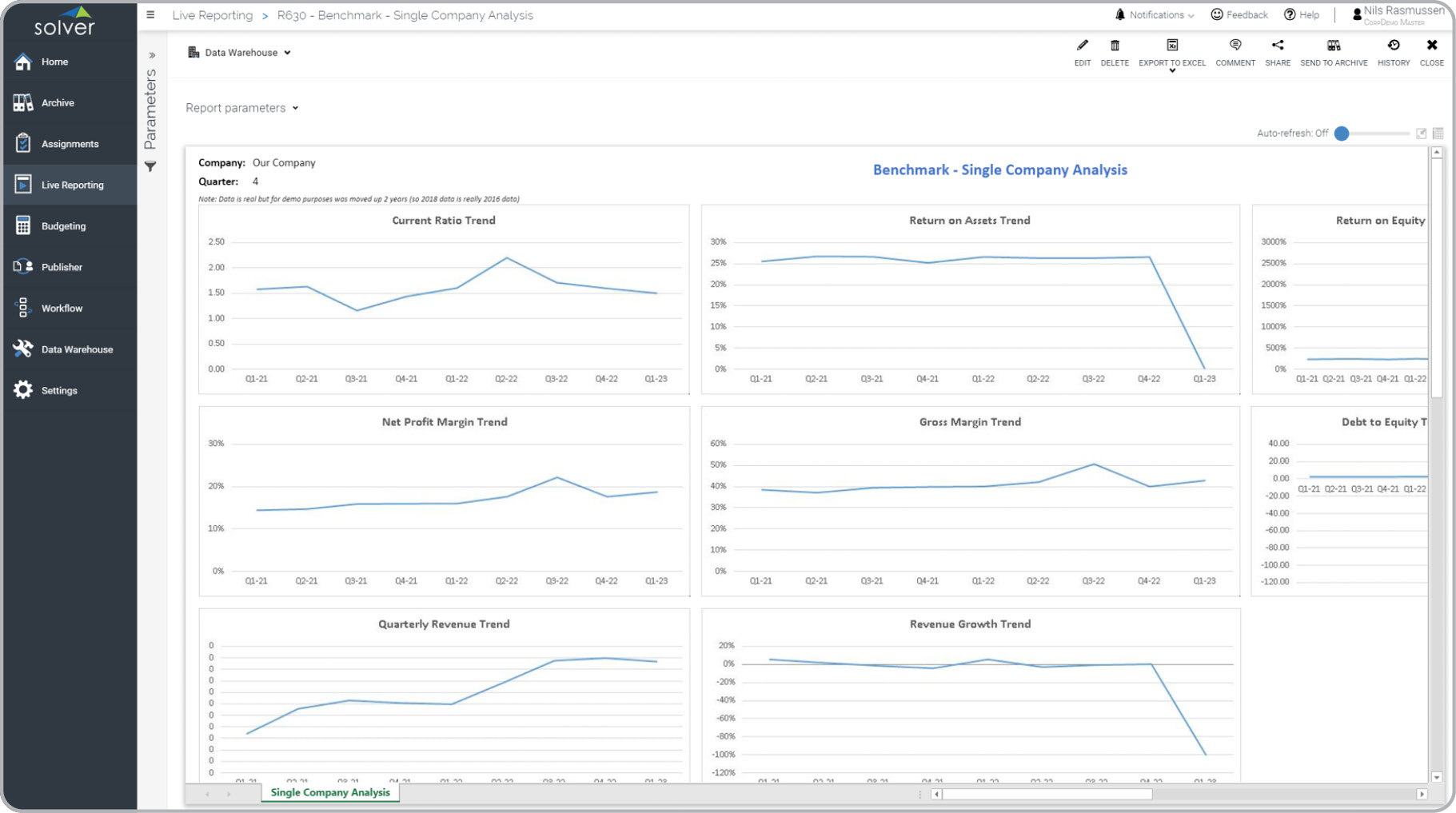Competitor Trend Analysis Report
What is
a
Competitor Trend Analysis
Report? Competitor analysis reports are considered benchmarking tools and are often used by CFOs, executives and analysts to track the performance and trends of similar or competing organizations. Some of the key functionality in this type of KPI benchmark report is that it is based on available data from competitors. Often, this is data from a web-site like Yahoo Finance or a government web-site like Edgar. The example consists of eight charts, each one displaying the trend for a specific metric for the past eight quarters. The metrics include: Current Ratio, Return on Assets, Return on Equity, Profit Margin, Gross Margin, Debt to Equity, Revenue and Revenue Growth. You find an example of this type of KPI benchmark report below.
Purpose of
Competitor Analysis Reports Companies and organizations use Competitor Analysis Reports to monitor the performance and trends of comparative businesses to know if their own business if falling behind or getting ahead. When used as part of good business practices in a Financial Planning & Analysis (FP&A) and Executive department, a company can improve its strategies as well as reduce the chances that performance targets, budgets and tactics are misaligned with the industry.
Competitor Analysis Report
Example Here is an example of a Competitor Performance Analysis Report with quarterly trend charts. [caption id="" align="alignnone" width="1821"]
 Competitor Trend Analysis Report Example[/caption] You can find hundreds of additional examples
here
Who Uses This Type of
KPI benchmark report
? The typical users of this type of KPI benchmark report are: CFOs, executives, board members, and analysts.
Other
KPI benchmark report
s Often Used in Conjunction with
Competitor Analysis Reports Progressive Financial Planning & Analysis (FP&A) and Executive Departments sometimes use several different Competitor Analysis Reports, along with benchmarking dashboards, comparative reports, KPI reports, strategy summaries and other management and control tools.
Where Does the Data for Analysis Originate From? The Actual (historical transactions) data typically comes from web sites like Yahoo Finance, Edgar or if the comparisons are to companies in e.g. the same corporate group, the data could come directly from enterprise resource planning (ERP) systems like: Microsoft Dynamics 365 (D365) Finance, Microsoft Dynamics 365 Business Central (D365 BC), Microsoft Dynamics AX, Microsoft Dynamics NAV, Microsoft Dynamics GP, Microsoft Dynamics SL, Sage Intacct, Sage 100, Sage 300, Sage 500, Sage X3, SAP Business One, SAP ByDesign, Acumatica, Netsuite and others. In analyses where budgets or forecasts are used, the planning data most often originates from in-house Excel spreadsheet models or from professional corporate performance management (CPM/EPM) solutions.
What Tools are Typically used for Reporting, Planning and Dashboards? Examples of business software used with the data and ERPs mentioned above are:
Competitor Trend Analysis Report Example[/caption] You can find hundreds of additional examples
here
Who Uses This Type of
KPI benchmark report
? The typical users of this type of KPI benchmark report are: CFOs, executives, board members, and analysts.
Other
KPI benchmark report
s Often Used in Conjunction with
Competitor Analysis Reports Progressive Financial Planning & Analysis (FP&A) and Executive Departments sometimes use several different Competitor Analysis Reports, along with benchmarking dashboards, comparative reports, KPI reports, strategy summaries and other management and control tools.
Where Does the Data for Analysis Originate From? The Actual (historical transactions) data typically comes from web sites like Yahoo Finance, Edgar or if the comparisons are to companies in e.g. the same corporate group, the data could come directly from enterprise resource planning (ERP) systems like: Microsoft Dynamics 365 (D365) Finance, Microsoft Dynamics 365 Business Central (D365 BC), Microsoft Dynamics AX, Microsoft Dynamics NAV, Microsoft Dynamics GP, Microsoft Dynamics SL, Sage Intacct, Sage 100, Sage 300, Sage 500, Sage X3, SAP Business One, SAP ByDesign, Acumatica, Netsuite and others. In analyses where budgets or forecasts are used, the planning data most often originates from in-house Excel spreadsheet models or from professional corporate performance management (CPM/EPM) solutions.
What Tools are Typically used for Reporting, Planning and Dashboards? Examples of business software used with the data and ERPs mentioned above are:
- Native ERP report writers and query tools
- Spreadsheets (for example Microsoft Excel)
- Corporate Performance Management (CPM) tools (for example Solver)
- Dashboards (for example Microsoft Power BI and Tableau)
Corporate Performance Management (CPM) Cloud Solutions and More Examples
December 1, 2020
TAGS:
Reporting,
Solver,
report writer,
Microsoft,
benchmark,
template,
practice,
Acumatica,
metric,
Netsuite,
Finance,
comparison,
GP,
dashboard,
Business Central,
excel,
ax,
forecast,
Budget,
forecasting,
budgeting,
KPI,
Cloud,
Software,
Tableau,
SAP,
example,
best,
Sage,
BC,
D365,
NAV,
Intacct,
CPM,
report,
SL,
Management,
dynamics,
Power BI,
edgar,
quarterly trend,
public company,
competitor analysis

